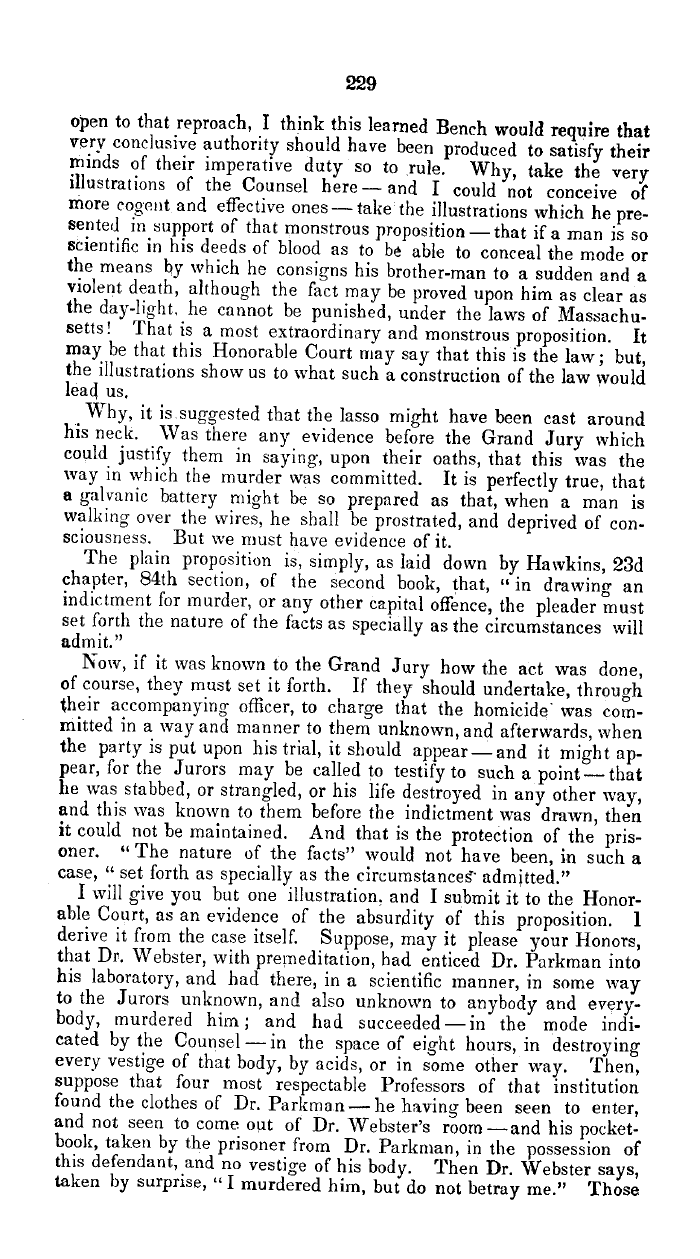|
229
open to that reproach, I think this learned Bench would require that
very conclusive authority should have been produced to satisfy their
minds of their imperative duty so to rule. Why, take the very
illustrations of the Counsel here-and I could not conceive of
more cogent and effective ones-take the illustrations which he pre-
sented in support of that monstrous proposition-that if a man is so
scientific in his deeds of blood as to be able to conceal the mode or
the means by which he consigns his brother-man to a sudden and a
violent death, although the fact may be proved upon him as clear as
the day-light, he cannot be punished, under the laws of Massachu-
setts! That is a most extraordinary and monstrous proposition. It
may be that this Honorable Court may say that this is the law; but,
the illustrations show us to what such a construction of the law would
lead us.
Why, it is.suggested that the lasso might have been cast around
his neck. Was there any evidence before the Grand Jury which
could justify them in saying, upon their oaths, that this was the
way in which the murder was committed. It is perfectly true, that
a galvanic battery might be so prepared as that, when a man is
walking over the wires, he shall be prostrated, and deprived of con-
sciousness. But we must have evidence of it.
The plain proposition is simply, as laid down by Hawkins, 23d
chapter, 84th section, of the second book, that, « in drawing an
indictment for murder, or any other capital offence, the pleader must
set forth the nature of the facts as specially as the circumstances will
admit."
Now, if it was known to the Grand Jury how the act was done,
of course, they must set it forth. If they should undertake, through
their accompanying officer, to charge that the homicide was com-
mitted in a way and manner to them unknown, and afterwards, when
the party is put upon his trial, it should appear-and it might ap-
pear, for the Jurors may be called to testify to such a point-that
he was stabbed, or strangled, or his life destroyed in any other way,
and this was known to them before the indictment was drawn, then
it could not be maintained. And that is the protection of the pris-
oner. "The nature of the facts" would not have been, in such a
case, °1 set forth as specially as the circumstance' admitted."
I will give you but one illustration, and I submit it to the Honor-
able Court, as an evidence of the absurdity of this proposition. I
derive it from the case itself. Suppose, may it please your Honors,
that Dr. Webster, with premeditation, had enticed Dr. Parkman into
his laboratory, and had there, in a scientific manner, in some way
to the Jurors unknown, and also unknown to anybody and every-
body, murdered him; and had succeeded-in the mode indi-
cated by the Counsel-in the space of eight hours, in destroying
every vestige of that body, by acids, or in some other way. Then,
suppose that four most respectable Professors of that institution
found the clothes of Dr. Parkman-he having been seen to enter,
and not seen to come out of Dr. Webster's room-and his pocket-
book, taken by the prisoner from Dr. Parkman, in the possession of
this defendant, and no vestige of his body. Then Dr. Webster says,
taken by surprise, 11 1 murdered him, but do not betray me." Those
|

